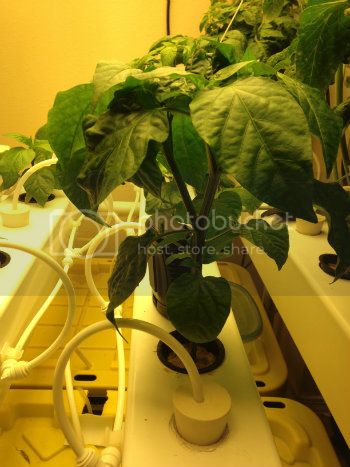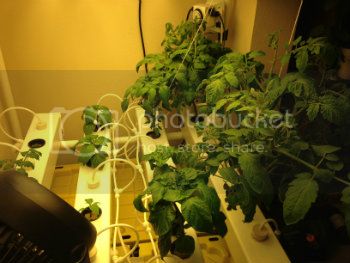-
Do you need help identifying a 🌶️?
Is your plant suffering from an unknown issue? 🤧
Then ask in Identification and Diagnosis.
You are using an out of date browser. It may not display this or other websites correctly.
You should upgrade or use an alternative browser.
You should upgrade or use an alternative browser.
High Pressure Aeroponics
- Thread starter hydromike
- Start date
is that a rubber stopper behind the emitters?
pretty clever brah.
edit: hey you dont want to blast air at your bulbs like that. you can confirm this with a cheap ass light meter, but when you are cooling the bulbs like that aggressively you are dimming the bulbs fairly considerably. ive done this with my PLL's to confirm and it definatly dims them even with a really crappy small fan.
let the bulbs get super hot and just blow air at the plants to keep them cool.
same thing happens with HPS MH etc etc. even filiment bulbs to a small extent.
pretty clever brah.
edit: hey you dont want to blast air at your bulbs like that. you can confirm this with a cheap ass light meter, but when you are cooling the bulbs like that aggressively you are dimming the bulbs fairly considerably. ive done this with my PLL's to confirm and it definatly dims them even with a really crappy small fan.
let the bulbs get super hot and just blow air at the plants to keep them cool.
same thing happens with HPS MH etc etc. even filiment bulbs to a small extent.
Yes indeed those are! Went up to the local brewery store and bought some solid 7 1/2 size stoppers and drilled them myself. Works great!
I didn't know that about the fan. I definitely want to get the max out of these bulbs given their price. Thanks for the tip!
So far the system seems to work really well and there has not been 1 clogged sprayhead. period. Not even visible salt buildup!
I didn't know that about the fan. I definitely want to get the max out of these bulbs given their price. Thanks for the tip!
So far the system seems to work really well and there has not been 1 clogged sprayhead. period. Not even visible salt buildup!
dont just take my word for it, you can read about it, or even better get a cheapo light meter from ebay.
its possible that cooling the bulbs prolongs their lives, idk . its also possible that there is some threshold to be had here... where some cooling might be beneficial and too much detrimental.
i have however never looked into the issue.
its possible that cooling the bulbs prolongs their lives, idk . its also possible that there is some threshold to be had here... where some cooling might be beneficial and too much detrimental.
i have however never looked into the issue.
Neato!
This system kicks ass! The plants have really taken off and I am sure that they have grown faster than I typically see my plants grow in a DWC. The only issue I have ran into is an algae bloom.... happens in almost any type of hydroponic system as you hydro growers know, but, it is a particularly bad problem in the HPA system because the algae clogs the sprayheads. I have not had any problems with sprayheads clogging from nutrient salt buildup so that is a good thing, but now I have learned that algae is probably going to be what clogs my sprayers. Luckily the John Guests make de-attachment and cleaning of the system parts very easy 
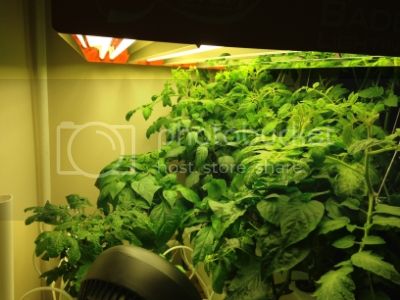

any root shots?
also look at adding hypochlorites to sanitize your system, such as bleach or calcium hypochlorite.
also look at adding hypochlorites to sanitize your system, such as bleach or calcium hypochlorite.
Bleach? Thats too harsh of a chemical for my liking, with the plants still in it of course. I will use sodium hypochlorite (bleach) once the current plants have produced their fruit and are worthless enough to throw out. The tubing/sprayheads/filter will soak in bleach, then antibacterial dish soap, then water. Same with the reservoir.
For now I added about 1/2 tbsp of H2O2 per gallon of water to help curb the algae growth. Hopefully that will help but if I get another bloom i'll have to take the system apart and clean it out again, which was a pain in the butt simply because it was every sprayhead that needed cleaning, not just one isolated piece.
OK now the root system... It is difficult to get a good picture because the plants are so large now. The best I can do is lift a rubber stopper and snap a picture inside the gully from an aerial perspective. The roots are looking good. Notably white, slightly fish-boned, and for the size of the plants the root mass is VERY small! In my case this is great because I can fit a Roma tomato inside my smaller choice of gully and still have plenty of room. As far as root fuzzies, there are some right now but not as many because the roots had dried out a bit while the algae had clogged the sprayheads.
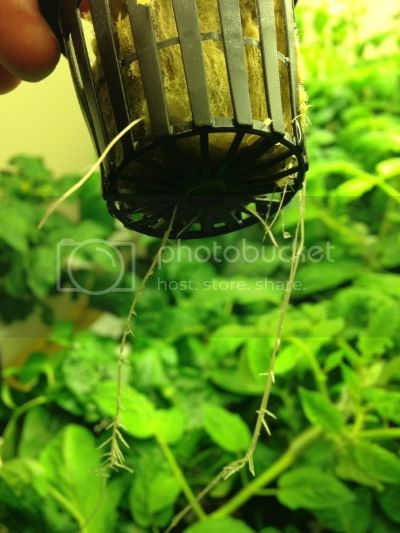
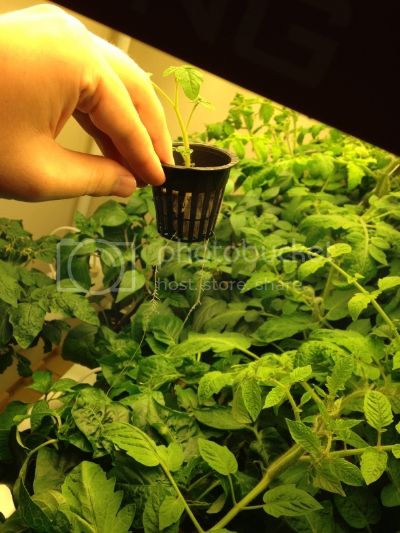
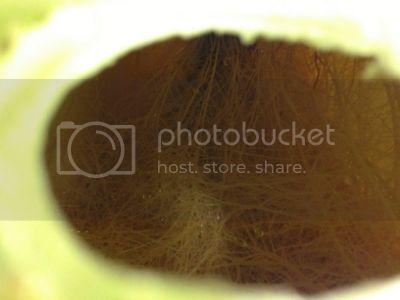
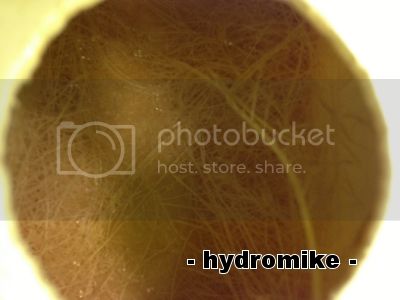
For now I added about 1/2 tbsp of H2O2 per gallon of water to help curb the algae growth. Hopefully that will help but if I get another bloom i'll have to take the system apart and clean it out again, which was a pain in the butt simply because it was every sprayhead that needed cleaning, not just one isolated piece.
OK now the root system... It is difficult to get a good picture because the plants are so large now. The best I can do is lift a rubber stopper and snap a picture inside the gully from an aerial perspective. The roots are looking good. Notably white, slightly fish-boned, and for the size of the plants the root mass is VERY small! In my case this is great because I can fit a Roma tomato inside my smaller choice of gully and still have plenty of room. As far as root fuzzies, there are some right now but not as many because the roots had dried out a bit while the algae had clogged the sprayheads.




bleach isnt harsh at all. if by harsh you mean high oxidation potential...
h202 is actually a much stronger oxidizer than hclo-( hypochlorous acid). hclo is an excellent way to disinfect water, and is preferable to h202 because of its ability to maintain useful residual levels. where as h202 decomposes much more quickly. i use it extensively to prevent alge blooms among other things.
of coarse you are probably using some weak concentration of h2o2.
if you want to see a harsh chemical reaction, try dropping an oxidant into some pure h202.
h202 is actually a much stronger oxidizer than hclo-( hypochlorous acid). hclo is an excellent way to disinfect water, and is preferable to h202 because of its ability to maintain useful residual levels. where as h202 decomposes much more quickly. i use it extensively to prevent alge blooms among other things.
of coarse you are probably using some weak concentration of h2o2.
if you want to see a harsh chemical reaction, try dropping an oxidant into some pure h202.
[background=rgb(255, 244, 228)]For now I added about 1/2 tbsp of H2O2 per gallon of water[/background]
Seems too weak to me to kill much of anything if you are using 3%. Try 1/4 cup and see if that helps. It decomposes quickly and adds extra oxygen in the water.
I am using 1tbsp/gal but I'm not trying to kill anything, just prevent it from growing. So far, so good although, I need more time with my system to see if it really prevents algee.
I have used 3% H2O2 in the past to get rid of algae growth with success and the plants showed no signs of stress after using it. The reason I don't want to use bleach is because they say you aren't supposed to use it in water that has chemicals added because it can lead to unwanted chemical products... yet you say it is safe so there is still potential for using it safely. If for some reason the hydrogen peroxide doesn't work then I may have to try out the bleach because algae is not something I want to have to worry about in this system. I just want some hot peppers to eat!


H[sub]2[/sub]O[sub]2[/sub] is widely used in hydroponics, because it's effective but doesn't do much damage to the roots. I wouldn't recommend preemptive use though, it'll oxidise everything, including your nutrients, so just use if needed.
If you're having frequent problems with algae, I'd recommend searching for light-leaks in your setup, the nutrient tank, the root-container and all the tubing should be light-proof.
If you're having frequent problems with algae, I'd recommend searching for light-leaks in your setup, the nutrient tank, the root-container and all the tubing should be light-proof.
are you saying HClO damages roots? because it dosent.
and what inorganic ion is h202 going to oxidize exatcly? i can see it destroying metal chelates, but not much else...not at any appreciable concentration.
and what inorganic ion is h202 going to oxidize exatcly? i can see it destroying metal chelates, but not much else...not at any appreciable concentration.
...i can see it destroying metal chelates, but not much else.
So just the most expensive part of our fertilizer then...
most expensive part? lol Idk how much stuff costs in AU, but here chelates are relatively cheap. what chelates are you using?
i use something like 7 grams of stem to make 35 gallons of 2ec nutrient solution. STEM costs $8 an Lb...
i can make 2000+ gallons of chelate solution for 8 bucks.
calcium nitrate at 4$/lb and 110 grams per 35 gallons costs me much more then my chelates...
in all likely hood i suspect you would need a relatively concentrated solution of h202 to destroy the chelate.
do you have any information to support your original claim or is this just supposition?
i use something like 7 grams of stem to make 35 gallons of 2ec nutrient solution. STEM costs $8 an Lb...
i can make 2000+ gallons of chelate solution for 8 bucks.
calcium nitrate at 4$/lb and 110 grams per 35 gallons costs me much more then my chelates...
in all likely hood i suspect you would need a relatively concentrated solution of h202 to destroy the chelate.
do you have any information to support your original claim or is this just supposition?
IDK, you can't mix your own fertilizer in Europe since apparently we'd all be terrorists if we were able to buy nitrates, but i remember our TA bitching about the Mg-complexes being expensive, but then again those were p.A.
[background=rgb(255, 244, 228)]
It's a hunch. I've seen pictures of iron deficient plants, that were hooked up to an H[sub]2[/sub]O[sub]2 [/sub]drip. If the H[sub]2[/sub]O[sub]2[/sub] was the source of the problem? Your guess is as good as mine.
You suspect, I suspect, it's a guessing game without data, but the discussion is quite academic anyways, my point was: Use it if you have to, I still don't see any advantage in preventive peroxide-use instead of light proofing.
[background=rgb(255, 244, 228)]
[/background]
do you have any information to support your original claim or is this just supposition?
It's a hunch. I've seen pictures of iron deficient plants, that were hooked up to an H[sub]2[/sub]O[sub]2 [/sub]drip. If the H[sub]2[/sub]O[sub]2[/sub] was the source of the problem? Your guess is as good as mine.
in all likely hood i suspect you would need a relatively concentrated solution of h202 to destroy the chelate.
You suspect, I suspect, it's a guessing game without data, but the discussion is quite academic anyways, my point was: Use it if you have to, I still don't see any advantage in preventive peroxide-use instead of light proofing.
Guys guys its no big deal, I personally will refrain from using H2O2, bleach, or anything else unless necessary as in this case with the algae bloom. I definitely have some areas where the light can leak into the system.
I purchased white RO tubing for the system because I read from a few sources that colored RO tubing (besides white) that is hit by UV light can leach nasty chemicals into the water. Thus, I chose white tubing. However, now I realize that the white tubing may be the reason algae is accumulating because it probably lets a little light through.
Reason for edit: typos
I purchased white RO tubing for the system because I read from a few sources that colored RO tubing (besides white) that is hit by UV light can leach nasty chemicals into the water. Thus, I chose white tubing. However, now I realize that the white tubing may be the reason algae is accumulating because it probably lets a little light through.
Reason for edit: typos
You could spray-paint it black (but use plastic primer first) or simply use some foam tube-insulation, something like this: http://www.zeruimetal.com/product-detail.aspx?id=96
too much hassle. just pump disinfectant(of your choice i guess) through the tubing. collect the spray without it reaching the roots.
its worth noting that bleach or even chlorine dioxide is very often incorporated into commercial greenhouse fertigation systems. what im proposing is nothing even close to new or unusual. chlorine disinfection in general has been around for like 80 years. i think they started sometime in the 20's it was late to america too.
its worth noting that bleach or even chlorine dioxide is very often incorporated into commercial greenhouse fertigation systems. what im proposing is nothing even close to new or unusual. chlorine disinfection in general has been around for like 80 years. i think they started sometime in the 20's it was late to america too.

